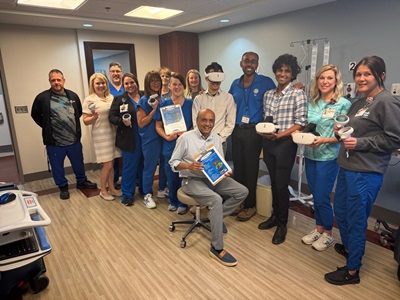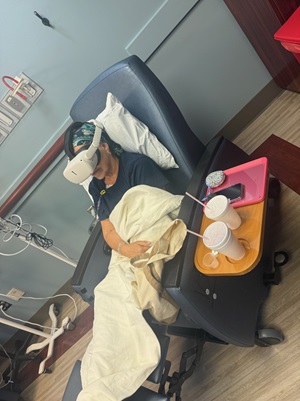 While chemotherapy symptom management has come a long way over the years, infusion appointments can still trigger anxiety and stress in patients receiving cancer treatment. To support individuals on their cancer journeys, Atrium Health Levine Cancer launched a virtual reality (VR) program at Atrium Health Wake Forest Baptist Hayworth Cancer Center at High Point Medical Center to alleviate anxiety and offer a welcome distraction during chemotherapy treatments.
While chemotherapy symptom management has come a long way over the years, infusion appointments can still trigger anxiety and stress in patients receiving cancer treatment. To support individuals on their cancer journeys, Atrium Health Levine Cancer launched a virtual reality (VR) program at Atrium Health Wake Forest Baptist Hayworth Cancer Center at High Point Medical Center to alleviate anxiety and offer a welcome distraction during chemotherapy treatments.
Dr. Bernard Chinnasami, medical director at the Hayworth Cancer Center, and Madison Skotcher, an oncology nurse, saw an opportunity to enhance the comfort and well-being of patients during chemo infusions. They championed a new supportive therapy to accompany chemotherapy infusions: virtual reality experiences.
Virtual reality technology creates three-dimensional, computer-generated imagery that simulates the sights and sounds of real environments. When wearing VR goggles, patients are transported to different places throughout the world (and even into outer space).
“Our innovative program embraces the power of virtual reality to uplift and support patients undergoing chemotherapy,” says Dr. Chinnasami. “By immersing them in captivating virtual environments, we can create a therapeutic and empowering experience that inspires hope, healing and renewed strength.”
VR experiences at Hayworth Cancer Center
At each infusion appointment, patients can choose from a menu of virtual reality experiences, including:
- Africa: A VR experience of the vast landscapes and beauty of the African continent.
- Jungle: A VR experience with the sights and sounds of a vibrant tropical rainforest and unique primates.
- Jurassic: A VR experience of the prehistoric world of dinosaurs.
- Oceans: A captivating virtual journey exploring the oceans surrounding Indonesia.
- Space: A behind-the-scenes VR experience of astronaut training and an exploration of the International Space Station.
Patients can tell their infusion nurse if they’d like to participate in a VR experience during that day’s infusion. If they are experiencing vertigo or nausea, the nurse will advise whether it’s a good idea for them to participate in VR that day.
Patients can watch the VR experiences from 15 to 45 minutes per infusion session. VR goggles are available in all 15 infusion rooms.
Skotcher describes the VR experience as the coolest project she has ever worked on and says patient feedback has been enthusiastic.
“I was surprised that patients over the age of 70 have been the biggest fans of VR,” she says. “They say things like, ‘Next time, I’m going to visit the International Space Station or go to Bora Bora.’”
Marla’s VR experience during chemo
 Marla Nicks retired from Atrium Health in July 2023, after 30 years of employment at the healthcare system, starting as a certified medical assistant and advancing to assistant vice president of the pediatric division in the Charlotte area. In spring 2025, Marla was diagnosed with B-cell non-Hodgkin lymphoma and chemotherapy is part of her treatment plan.
Marla Nicks retired from Atrium Health in July 2023, after 30 years of employment at the healthcare system, starting as a certified medical assistant and advancing to assistant vice president of the pediatric division in the Charlotte area. In spring 2025, Marla was diagnosed with B-cell non-Hodgkin lymphoma and chemotherapy is part of her treatment plan.
“I usually go for my treatment and then I have about 10 days where it’s kind of touch and go,” says Marla. “I’m not sick, I just don’t feel great or have a lot of energy. Then I feel better for about eight to 10 days and then it’s time for another treatment.”
Marla began participating in the VR experiences during her second chemo session.
“I would love to go on an African safari — it’s been a dream trip for me, so that’s why I chose that one first,” she says. “I love the animals out in the wild like that, so it was really interesting and fun for me.”
During her next chemo infusion, she opted for the ocean experience.
“It was like being underwater, seeing all those fish,” she says. “It’s cool.”
For Marla, the VR experiences have made a positive difference in her treatment.
“It definitely takes your mind somewhere different,” she says. “It can be a long day. I take my iPad and watch movies or read, but I haven’t been able to read a lot during chemo because it makes my brain a little foggy and it’s hard to focus. Virtual reality helps because it really does take you to a place you’ve never been before.”
She’s grateful for the care she’s received at Hayworth Cancer Center.
“I have nothing but good, positive things to say about my experience,” says Marla. “I love Dr. Chinnasami, the nursing staff and the volunteers.”
The future of the VR program
Hayworth Cancer Center is launching a new VR Program, 2.0, called the Bucket List Initiative. This program is designed to provide patients with meaningful virtual experiences that they may not otherwise be able to access. For example, if someone has always dreamed of visiting Paris, the team can arrange a VR “walk” through the city with their family and friends (up to six people), followed by a themed tea party with French treats, giving them a chance not only to explore, but also savor the experience with loved ones.
So far, patient requests have ranged from a tour of the White House, Italy, Paris, Japan, specific beaches and the Masters Tournament, says Skotcher.
Because the VR program has been so popular at Hayworth Cancer Center, Skotcher and Chinnasami are now working to expand the program to other Atrium Health Levine Cancer sites.
Learn more about cancer services at Atrium Health Wake Forest Baptist.
